Visiting Kyoto is a must for anyone interested in travelling to Japan. Once the country’s capital for thousands of years, this ancient city served as the centre of culture and progress. While its political power waned throughout the years, it remains a city of culture even now. Take a walk in time and witness the beauty of the old imperial capital through these places in Kyoto.
Also read: 10 Best Airbnb Homes & Vacation Rentals in Japan for the Trip of a Lifetime
Kyoto historical sites that are essential to knowing the city
1. Heian Jingu Shrine
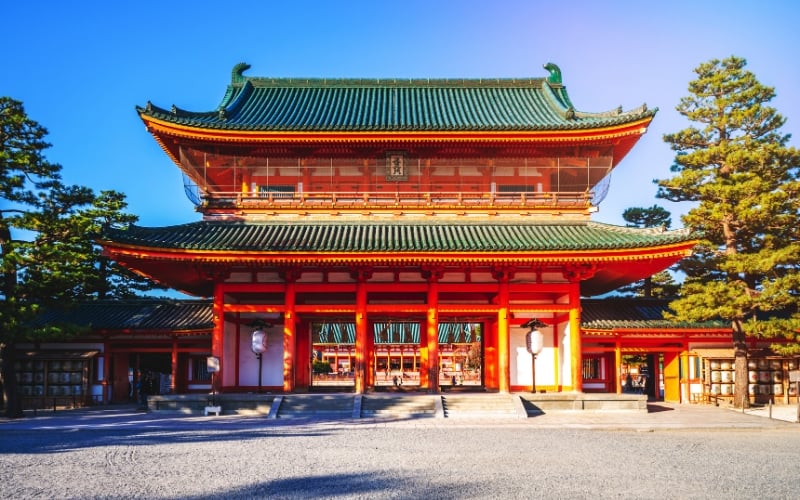
Image credit: Dorin Tamas via Canva Pro
One of the most famous Kyoto historical sites is Heian Jingu Shrine (or simply Heian Shrine), named after Kyoto’s former name, Heian. It has a relatively younger history compared to other shrines in the city, having only been built in 1895. Enshrined inside Heian Jingu are the first and last emperors of Heian: Emperor Kammu and Emperor Komei.
Take note of the Jidai Matsuri when planning a visit to the shrine. Held on the 22nd day of October, it is among the popular cultural attractions in Kyoto. This festival features a parade that commemorates the founding of Kyoto, with Heian Jingu Shrine as its centre stage.
2. Fushimi Inari Shrine
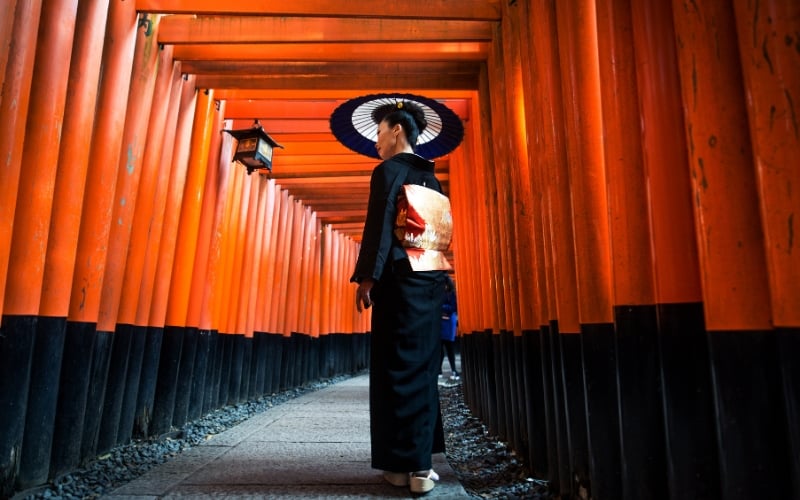
Image credit: Oneinchpunch via Canva Pro
Visiting the Fushimi Inari Shrine is not just a breathtaking experience because of its vermillion palette from torii gates. Seeing this ancient Kyoto shrine is also integral to understanding the city’s rise in influence. The shrine dates back to the 8th century and is the centre of worship for the Shinto goddess of harvest, Inari.
Its most eye-catching feature is the paths filled with torii gates. Businesses and corporations donated these sacred structures, either out of gratitude or as an offering to the spirits. Regardless of the intention or purpose, the gates contribute to the reverence of the shrine.
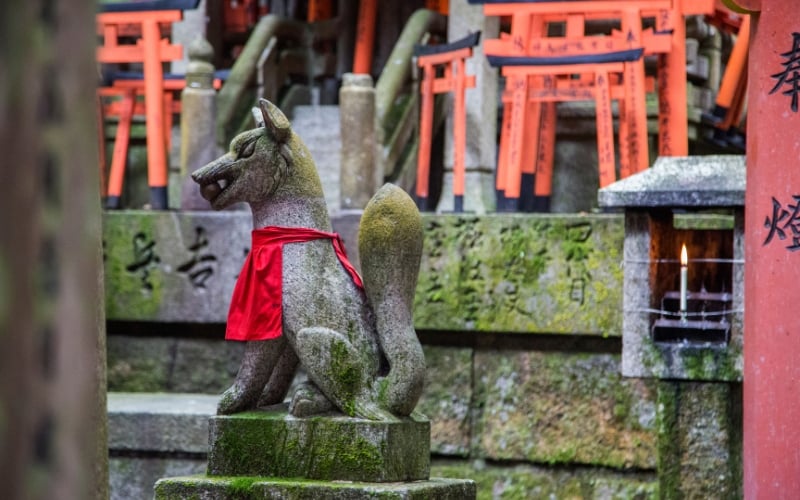
Image credit: BGStock72 via Canva Pro
Fox statues are also prevalent within the grounds and pathways of Fushimi Inari Shrine. Japanese folklore reveres foxes since they act as messengers to the goddess Inari, and the statues are reminders of that belief. Remember, rubbing their noses and making an offering to these statues bring good fortune!
3. Nijo Castle
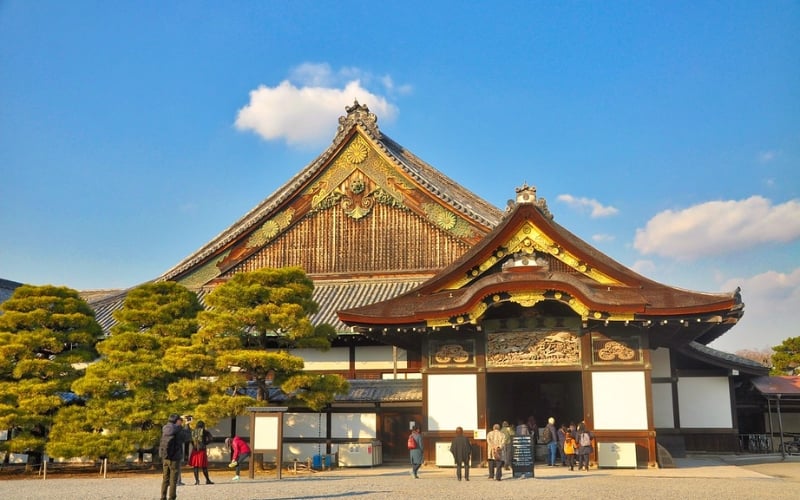
Image credit: Eustaquio Santimano
The Tokugawa Shogunate was pivotal in shaping the direction of modern Japan. Their patriarch Ieyasu Tokugawa and high-ranking members of his clan took residence in Nijo Castle.
This palace was certainly fit for one of the most influential leaders of Japan. Some historians and artists consider the elaborate wood carvings on the palace walls and immaculately manicured gardens the pinnacle of Japanese art and design. Today, it is one of the most popular cultural attractions in Kyoto, with its museum being a highlight for tourists.
4. Nishiki Market
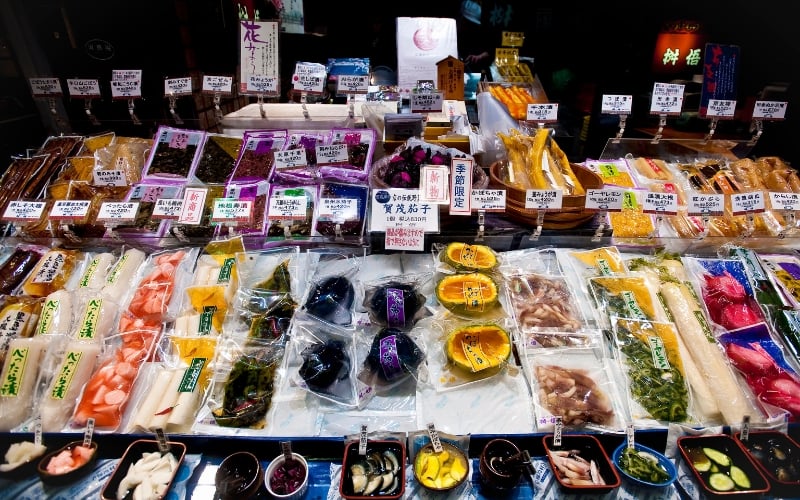
Image credit: gyro via Canva Pro
Nishiki Market is an excellent destination in Kyoto, especially for adventurous foodies. Famously known as “Kyoto’s Kitchen,” this food market has a 400-year history of selling the most delicious food in the city.
Unique to the market are vegetables grown from the local countryside, with most crops possessing crunchiness beyond compare. Delicious traditional Japanese sweets like rice crackers and cakes are also sold here. It is certainly among the best places in Kyoto to stop by for souvenirs and more!
5. Yasaka Shrine
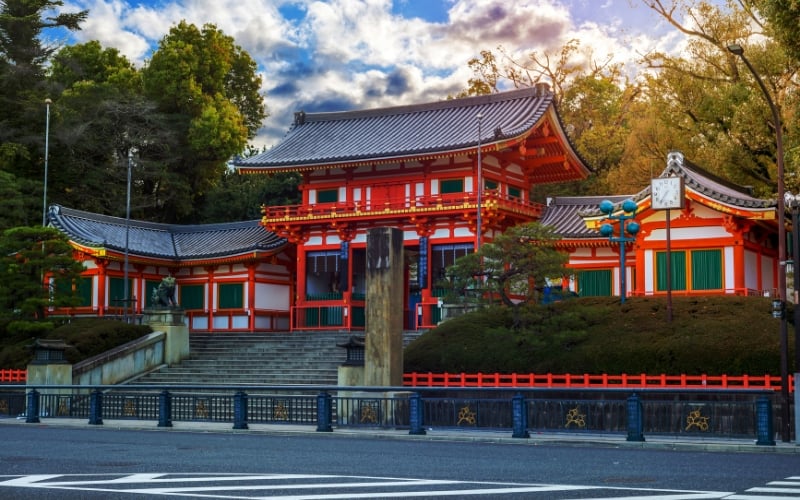
Image credit: Dorin Tamas via Canva Pro
Gion district is one of the best places in Kyoto to explore. The city’s history and culture are very much alive here, evident in the concentration of traditional tea houses and geisha. At the centre of this entertainment district is the equally historic Yasaka Shrine.
Kyoto built this shrine for Shinto gods, but primarily, the powerful deity Susanoo-no-Mikoto and his wife, Kushinadahime-no-Mikoto. The deities would certainly feel honoured, especially with the decadent architecture of Yasaka Shrine. For this reason, the shrine plays host to Gion Matsuri, one of Kyoto’s most important festivals.
Also read: 10 Must-See Temples and Shrines in Japan
Places in Kyoto to see gorgeous temples
6. Kinkaku-ji (Golden Pavilion)
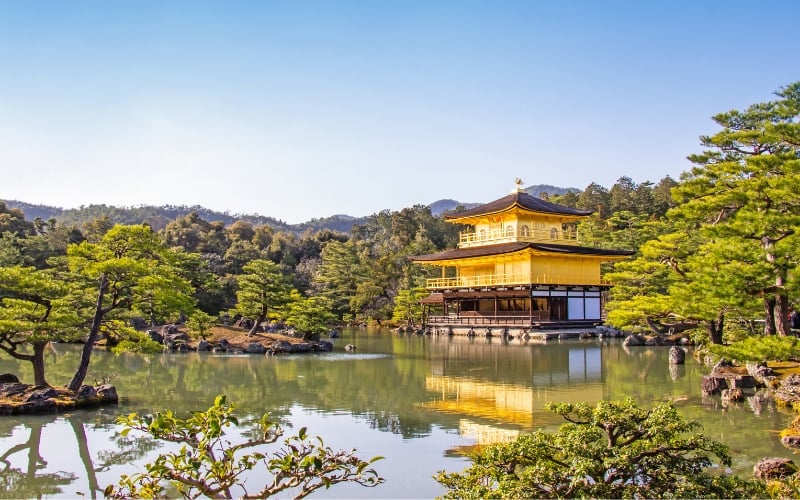
Image credit: prapstock via Canva Pro
One of the most popular UNESCO World Heritage Sites in Kyoto is the opulent Kinkaku-ji temple. It is also known as the Golden Pavilion, since its two topmost floors shine because of their gold-leaf plating. This gold is sacred to the temple, as folklore suggests the colour deflects ill feelings about death.
While it’s famous as a Zen temple today, it was actually a villa for the shogun Ashikaga Yoshimitsu during the 14th century. His son repurposed the residence into the temple we know today. Kinkaku-ji is also home to ancient relics, statues, and scrolls highly relevant to Buddhist belief.
Also read: Kyoto Sakura Season Guide: Everything You Need to Know for Your Trip
7. Ginkaku-ji (Silver Pavilion)
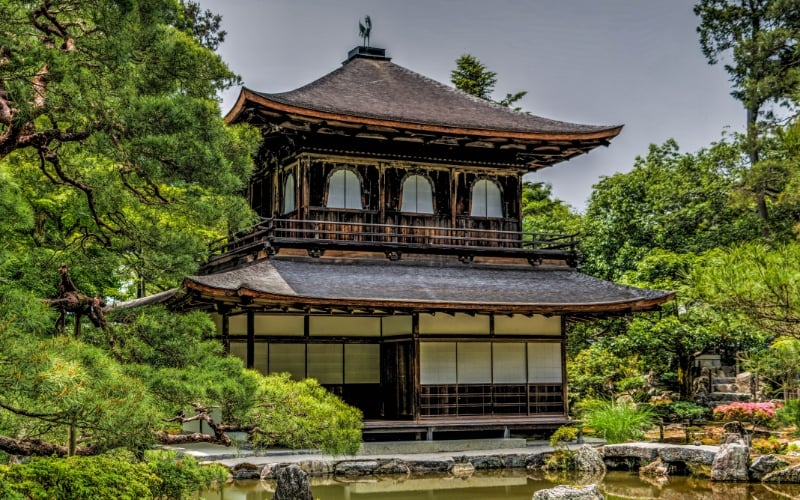
Image credit: Michelle_Maria via Canva Pro
An equally relevant and stunning counterpart to Kinkaku-ji is Ginkaku-ji temple, or the Silver Pavillion. Shogun Ashikaga Yoshimasa intended Ginkaku-ji to be an exact replica of Kinkaku-ji, as a tribute to the clan patriarch’s legacy.
Silver leaves were meant to cover its exterior walls, however, the budget didn’t meet the vision. Much like its golden twin, the villa was turned into a Zen temple as an offering.
8. To-ji Temple
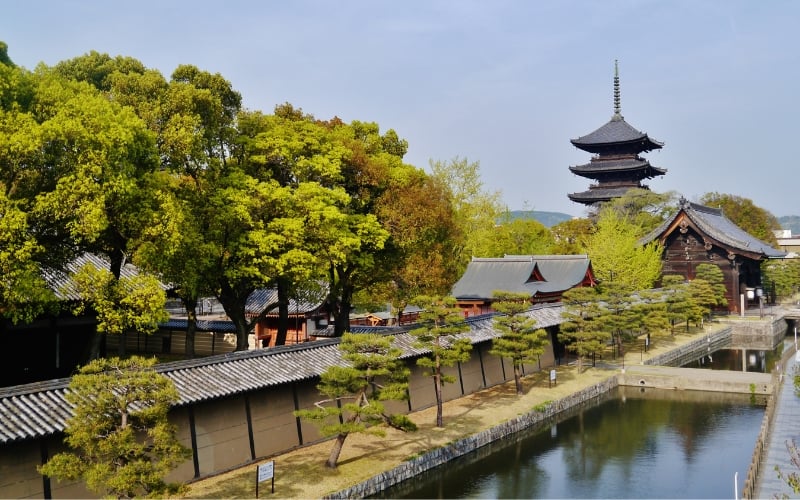
Image credit: Zairon
To-ji Temple is also among the numerous Kyoto historical sites that tourists should visit. The five-storey pagoda, which stands 57 metres tall, is enough to grab anyone’s attention. It was once the tallest Buddhist temple in Japan and remains to be a prime example of Heian architecture. During the Meiji era, the government spared razing To-ji Temple to the ground when Buddhism and Shinto were being separated. Thankfully, locals and visitors can look at To-ji Temple as a symbol of peace and resilience.
Be sure to take a look around the temple’s flea market! It is held every 21st of the month, where unique souvenirs can sometimes make an appearance. Just browsing is always an option, of course!
9. Tenryu-ji Temple
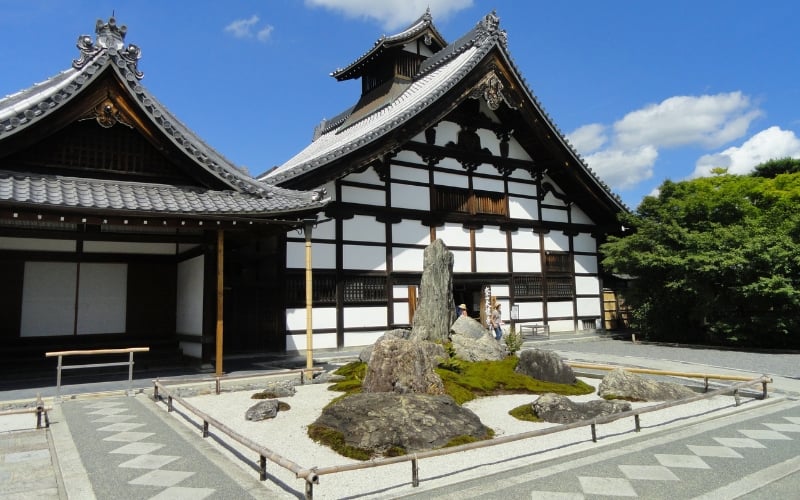
Image credit: Daderot
It seems the Ashikaga shogunate had built many World Heritage Sites in Kyoto, even before the distinction came to be. The clan’s first shogun, Ashikaga Takauji, had Tenryu-ji Temple built in 1339 as a tribute to Emperor Go-Daigo. Over time, the temple had more designs added to it, the most notable being a garden designed by Zen master Muso Soseki. Since the temple is also surrounded by natural beauty, visitors are also welcome to take a stroll through its groves or go for a boat ride down the Hozu River.
10. Kiyomizu-dera Temple
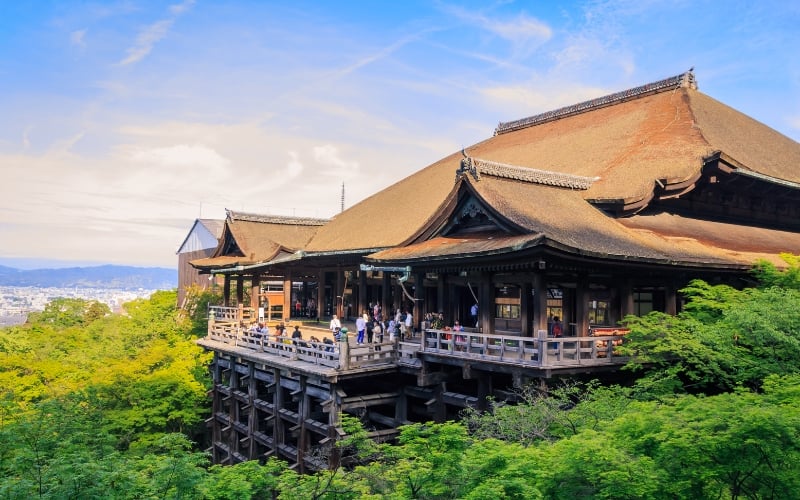
Image credit: Reginald Pentinio
Reaching Kiyomizu-dera Temple is a sensory overload. From the moment visitors set foot on the main hall veranda, an unbridled view of Kyoto’s natural beauty welcomes the eyes. Various colours and landscapes make the view seem like a living painting.
At the base of the temple’s main hall is Otowa Waterfall. Aside from being potable, most locals believe that the streams coming from the waterfall affects fortune. From success in businesses to finding love, every stream is, apparently, life-changing!
Also read: From Kyoto to Fukuoka: 7D6N in Western Japan for Your Spring 2023 Holiday
Naturally, there are still so many historical places in Kyoto that it will take days to see all of them! It is the cultural capital of Japan for a reason. Nonetheless, Kyoto is one of the most rewarding cities to explore and will get anyone interested in Japanese history in no time.
Featured image credit: rabbit75_cav via Canva Pro




